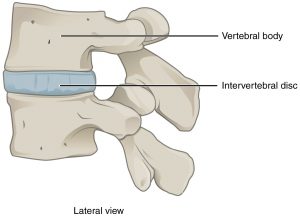Have you got a spring in your step or are you still feeling the winter blues? With April upon us, everything is blossoming, growing and moving as nature intended. But are you?
68% of us will have some sort of back problem by the time we are 40. It’s an age thing and here’s why that 68% may well include you.
The spine is made up of small bones called vertebrae. In between each of these vertebra is a disc like structure which is there to provide a cushion against the forces placed on the spine during daily activities. Another function of these little discs is to allow dynamic movement of the spine. All very good, as long as we are moving.

With age, these vertebral bodies and discs begin to wear due to prolonged use, the effects of gravity and perhaps even injury or overexertion. This can eventually cause a reduction in the size of the vertebra and the discs resulting in a consequent reduction in length of the overall spine. This is why we become shorter as we get passed middle age and into older age. It is proven that on average, 68% of us will have some disc degeneration by the time we are 40 years old resulting in disc height loss in 45% of those cases. And this is without painful symptoms. In other words, you don’t even know about it.
So how do you keep the springiness in your spine?
Now… there’s not much you can do about the passage of time. Just as with nature, your body is not designed to last forever but you can influence the health of your spine (and all your other joints for that matter). There’s no magic formula or elixir I’m afraid. Its simply a case of movement. And more of it than most of us are doing.
Activity is essential to maintain the exchange of fluids in spinal structures. It also helps to reduce swelling that naturally occurs in the tissues surrounding an injured disc. So whether you’ve experienced the debilitating pain of disc injury or not… movement will be of great benefit to maintain spine health. You don’t need to go crazy down at the gym or sweat yourself silly at the spin class. There’s a much simpler and quite frankly, more enjoyable solution…
Walk your way to a healthier spine
Walking strengthens the muscles in your torso, legs, feet, and other areas, which enable your body to remain in the ideal postural position. Where some aerobic activity may be too strenuous for some people with low back pain, walking is gentle enough for most people and can actually help to reduce pain.

Even a modest rise in your activity level, such as a daily 15-minute walk, can greatly improve your spine health. Spinal stability and strength are greatly improved by walking and other forms of activity.
Lower your risk of back injury with increased flexibility
Stretching and exercising regularly aids in increasing flexibility and range of motion of your joints. Pay attention to your posture as you walk or engage in other exercises. By paying more attention to your posture, you can lower your risk of back injuries.
Improve your circulation
The cardiovascular benefits of regular exercise are well known. However, not a lot of people know that improved blood circulation benefits your spine as well. With a healthier and stronger circulatory flow, the tissues which support your spine receive more nutrients and the toxins are flushed away. This brings overall good health to your spine, enabling you to move more freely and reduce pain.
So what are you waiting for? It’s not rocket science and it’s not difficult but it is so, so important. Get walking this spring and get a spring in your step!



